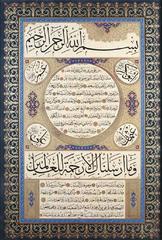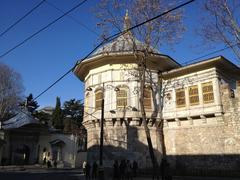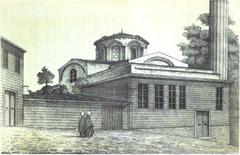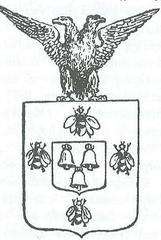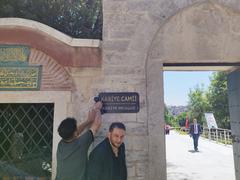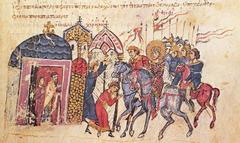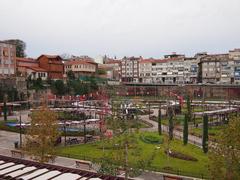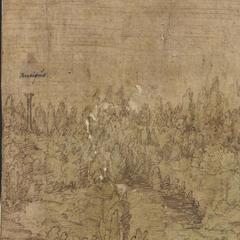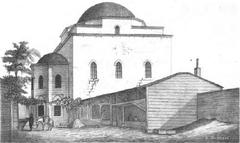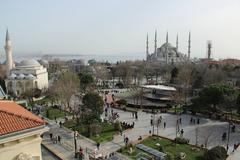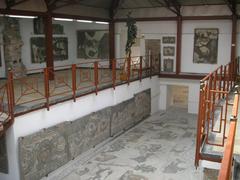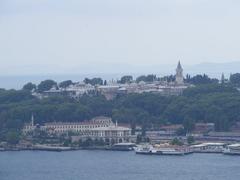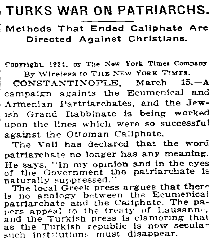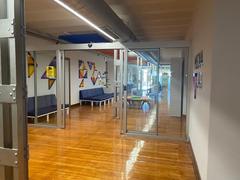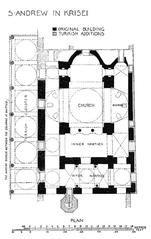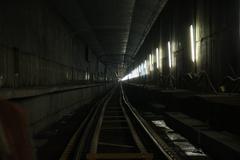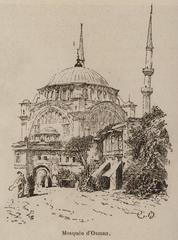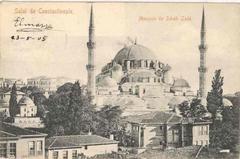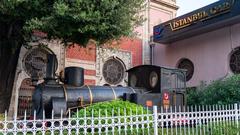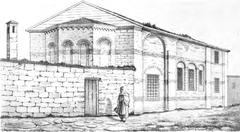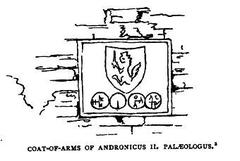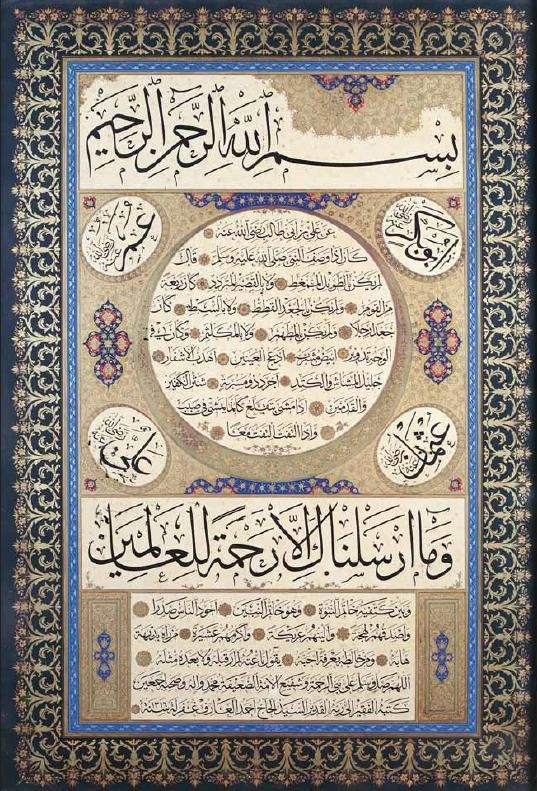
Mesih Mehmed Pasha Mosque Visiting Hours, Tickets, and Fatih Historical Sites Guide
Date: 14/06/2025
Introduction
Nestled in the historic Fatih district of Istanbul, the Mesih Mehmed Pasha Mosque stands as a remarkable testament to Ottoman architectural mastery and enduring religious heritage. Commissioned by Grand Vizier Mesih Mehmed Pasha in the late 16th century, the mosque blends spiritual devotion, sophisticated design, and civic purpose. This comprehensive guide offers detailed information on visiting hours, ticket policies, accessibility, architectural features, historical context, visitor etiquette, and nearby attractions—ensuring you enjoy a rich and respectful visit to this lesser-known gem of Istanbul (Archnet, Wikipedia).
Table of Contents
- Introduction
- Historical Context and Significance
- Architectural Features
- Visiting Information
- Visitor Etiquette and Dress Code
- Facilities and Security
- Photography Tips
- Preservation and Restoration
- Nearby Attractions and Suggested Itineraries
- Practical Tips for Visitors
- Frequently Asked Questions (FAQ)
- Conclusion and Call to Action
- References and Useful Links
Historical Context and Significance
The Ottoman Architectural Renaissance
The Mesih Mehmed Pasha Mosque was constructed during the architectural zenith of the Ottoman Empire, a period characterized by grand mosque complexes, harmonious proportions, and innovative engineering. Designed by the legendary Mimar Sinan or his immediate circle, the mosque reflects the mature phase of Ottoman architecture with its central dome, semi-domes, and careful urban integration (Istanbul Clues). This era saw mosques serve not only religious functions but also act as centers for education and welfare.
Mesih Mehmed Pasha: Patron and Legacy
Mesih Mehmed Pasha, who rose to the position of Grand Vizier under Sultan Murad III, embodied the Ottoman tradition of statesmen funding public works as acts of piety and civic duty. His mosque, completed in the late 1580s, was designed to serve both spiritual needs and the broader community, with attached facilities such as madrasas and kitchens (SAO Architects).
Architectural Features
Exterior and Interior Design
- Exterior: Built from finely cut limestone and marble, the mosque’s exterior features a grand central dome (12.8 meters in diameter), flanked by semi-domes and supported by buttresses. The single minaret displays elegant restraint, with a single balcony and detailed stonework.
- Courtyard: A rectangular courtyard (avlu) precedes the mosque, enclosed by a colonnaded portico with 16 domed bays and an ornate ablution fountain (şadırvan) at its center (Archnet).
- Interior: The prayer hall is spacious and filled with natural light from two tiers of windows, creating an uplifting atmosphere. The mihrab and minbar are crafted from white marble, decorated with geometric and floral motifs, while Quranic calligraphy in thuluth script adorns the walls and dome.
- Tilework: Select panels of blue-and-white Iznik tiles, painted arabesques, and floral motifs accent the mihrab and lunettes, reflecting classical Ottoman tastes.
Structural Innovations
The mosque incorporates advanced earthquake-resistant features, including thick walls, buttresses, and a balanced dome system. These techniques have helped the building withstand multiple earthquakes with minimal damage (Archnet).
Social and Educational Functions (Külliye)
Originally, the mosque complex included a madrasa (Islamic school), primary school, fountain, and the tomb of Mesih Mehmed Pasha. This reflects the Ottoman külliye tradition, where religious, educational, and social services were integrated within the same complex (Archnet).
Artistic and Cultural Importance
The mosque’s harmonious proportions and restrained decoration represent the transition from classical to late classical Ottoman architecture. It stands as a monument to the significant role viziers played in shaping Istanbul’s urban and cultural landscape.
Visiting Information
Visiting Hours and Admission
- Hours: Open daily from 9:00 AM to 6:00 PM. Best to avoid prayer times, especially Friday noon prayers, for a more peaceful visit.
- Admission: Entry is free of charge; donations for maintenance are welcomed.
- Changes during Holidays: Hours may vary during Ramadan and Islamic holidays—check local announcements or the mosque’s notice board for updates (GoTurkey Tourism).
Accessibility
- Physical Access: Ramps at the entrance and level flooring inside make the mosque accessible to wheelchair users and those with limited mobility, though some historical features may pose challenges.
- Amenities: Clean restrooms and ablution facilities are available in the courtyard.
Getting There
- Address: Mesih Paşa Mahallesi, Yavuz Sultan Selim Cd. No:1, 34083 Fatih/İstanbul, Turkey.
- Public Transport: Nearest tram stop is Cibali (T5 line), a 5-minute walk away. Tram lines T1 (Sultanahmet stop), buses, and taxis are also convenient; parking is limited (Istanbul Metro Map).
- Walking: The mosque is a short walk from Fener, Balat, and the Golden Horn waterfront—ideal for exploring multiple historic neighborhoods.
Tours and Audio Guides
- Guided Tours: Local tour operators include the mosque in walking tours of Fatih, Fener, and Balat (Istanbul Tour Studio). Official guided tours at the mosque are rare, but informational plaques are available in Turkish and English.
- Audio Guides: Downloadable via the Audiala app, offering in-depth insights into the history and architecture.
Best Times to Visit
- Optimal Times: Mid-morning or late afternoon on weekdays for fewer crowds and optimal lighting.
- Avoid: Friday noon prayers and major religious holidays unless you wish to observe community worship.
Visitor Etiquette and Dress Code
- Dress Modestly: Women should cover their heads, shoulders, and knees (scarves often provided, but bringing your own is best). Men should avoid shorts and sleeveless shirts.
- Shoes: Remove before entering the prayer hall; bags for shoes are usually supplied.
- Behavior: Maintain silence, avoid mobile phone use, and refrain from eating or drinking inside.
- Photography: Allowed outside prayer times, but always be discreet and respectful.
Facilities and Security
- Restrooms and Ablution Areas: Located in the mosque courtyard.
- Safety: The area is safe and well-patrolled, but remain vigilant and keep belongings secure, especially during busy periods.
- Accessibility: While the mosque is largely accessible, visitors with special needs should contact the mosque administration in advance for assistance.
Photography Tips
- Capture the mosque’s exterior in early morning light for dramatic shadows.
- The interior’s natural light is best during late afternoon; avoid flash and be mindful of worshippers.
- Focus on details such as the mihrab, stained-glass windows, Iznik tiles, and the tranquil courtyard.
Preservation and Restoration
The mosque has undergone several restorations to preserve its original features, especially after earthquakes. Conservation efforts focus on the stonework, lead dome covering, and cleaning of marble and tile surfaces, ensuring the site remains both a functioning mosque and a protected monument (Archnet).
Nearby Attractions and Suggested Itineraries
- Fener and Balat: Explore colorful streets, historic churches, and the Greek Orthodox Patriarchate.
- Chora Church (Kariye Museum): Renowned for its Byzantine mosaics (Kariye Museum).
- Golden Horn Waterfront: Offers scenic views and boat tours.
- Fatih Mosque and Yavuz Sultan Selim Mosque: Major Ottoman-era sites nearby.
- Grand Bazaar: Iconic market for shopping and local culture.
Suggested Itinerary: Start with the mosque in the morning, stroll through Fener and Balat, enjoy lunch at a local café, and end with a visit to the Chora Church.
Practical Tips for Visitors
- Footwear: Wear shoes that are easy to remove.
- Clothing: Dress conservatively; women should bring a headscarf.
- Timing: Visit weekday mornings for a peaceful experience.
- Language: Basic English is spoken; learning Turkish greetings is appreciated.
- Hydration: Bring water, especially in summer.
- Cash: Carry small amounts for donations or local purchases.
- Respect: Maintain decorum, especially during prayer times.
Frequently Asked Questions (FAQ)
Q: Are there tickets required for Mesih Mehmed Pasha Mosque?
A: No, entry is free of charge.
Q: What are the mosque’s visiting hours?
A: Open daily from 9:00 AM to 6:00 PM, except during prayer times and on Friday noon.
Q: Is the mosque accessible for visitors with disabilities?
A: The mosque has ramps and level flooring, but contact administration for specific needs.
Q: Can I take photographs inside the mosque?
A: Yes, but only outside prayer times and with discretion.
Q: Are guided tours available?
A: Local tour companies include the mosque in area tours; official mosque tours are rare.
Visuals and Media
- [Insert high-resolution images with alt texts: “Mesih Mehmed Pasha Mosque Istanbul exterior,” “Ottoman dome architecture at Mesih Mehmed Pasha Mosque,” “Ablution courtyard of Mesih Mehmed Pasha Mosque,” “Tomb of Mesih Mehmed Pasha.”]
- [Embed interactive map pinpointing the mosque location in Fatih.]
- [Include virtual tour links if available.]
Conclusion and Call to Action
The Mesih Mehmed Pasha Mosque remains a distinguished jewel of Istanbul’s Ottoman heritage, inviting visitors to immerse themselves in centuries of architectural ingenuity and spiritual tradition. Its harmonious design, peaceful courtyard, and rich history offer an experience that bridges past and present. With free admission, accessible facilities, and proximity to other historical sites, it is a must-visit for anyone exploring Istanbul’s cultural heart.
For the latest updates, guided tours, and immersive audio guides, download the Audiala app and follow us on social media. Continue your journey by exploring related articles on Ottoman architecture and Istanbul’s historical sites.
References and Useful Links
- Mesih Mehmed Pasha Mosque on Archnet
- Mesih Mehmed Pasha Mosque on Wikipedia
- Istanbul Clues: Best Mosques
- GoTurkey Tourism
- Nomadic Niko: Istanbul Mosque Guide
- Istanbul.tips: Islamic Heritage Sites
- Istanbul Metro Map
- Istanbul Tour Studio
- Istanbul Archaeological Museums
- Kariye Museum (Chora Church)
- Fatih Municipality: Selatin Mosques
- Istanbul Police Department
